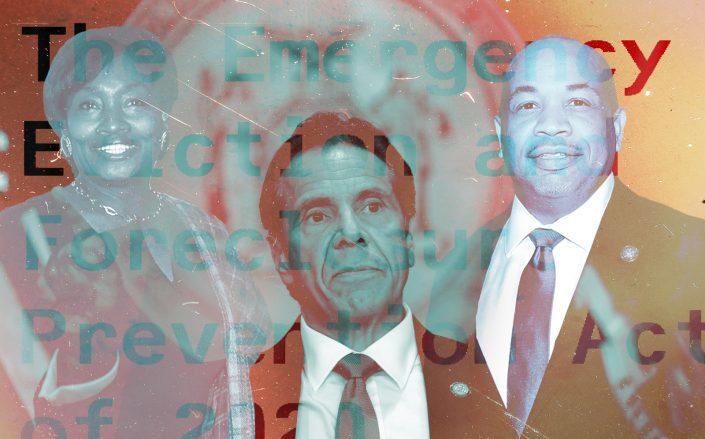
New York Assembly Speaker Carl Heastie, Gov. Andrew Cuomo and Senate Majority Leader Andrea Stewart-Cousins (Getty)
UPDATED, Dec. 28, 2020, 7:55 p.m.: Landlords are feeling uneasy as new legislation to stop evictions for two months is about to become law.
The state Senate and Assembly voted today to pass the Emergency Eviction and Foreclosure Prevention Act of 2020, which will limit evictions and foreclosures on some properties until May 1, and put all such matters on ice for two months. Tenants and property owners with fewer than 10 units can access protection from eviction or foreclosure, respectively, by filling out a hardship declaration form.
“There has not been nearly enough done to prevent a full-blown housing crisis from erupting as a result of the covid-19 pandemic,” said Queens Sen. Michael Gianaris, the deputy majority leader of the state Senate. “This moratorium is a good step to ensure New Yorkers don’t get thrown out of their homes at a time when we’re asking people to stay in their homes. We must do even more to provide real relief in the months ahead.”
During a press conference Monday, Gov. Andrew Cuomo spoke in support of the measure, and said he would sign the bill once it passed in the legislature.
“We want to protect tenants, we want to make it simple, we don’t want people to get evicted, we don’t want them to have to go to court to fight the eviction,” said Cuomo. “But we want to make sure they’re not committing fraud either, so they will make representations that are legally enforceable.”
News of the bill was met by dismay from property owners, although some acknowledged that the scaling-back of previous proposals for an eviction ban demonstrated that lawmakers have not spurned landlords entirely.
Criticism of the bill centered on its lack of financial aid to renters or landlords, and absence of means-testing.
Jay Martin, executive director of the Community Housing Improvement Program, called the legislation a “stall tactic.”
“Closing the courts for a few months will not relieve the massive debt that tens of thousands of renters face, or provide any financial relief to the hundreds of housing providers who have provided safe, clean homes to millions of New Yorkers during the Covid-19 emergency,” said Martin.
The legislation doesn’t pay down rent arrears, which could now total as much as $3.4 billion statewide, according to a study from the National Council of State Housing Agencies. That study, conducted at the end of September, estimated that anywhere from 800,000 to 1.2 million households are behind on rent, and that there could be 730,000 evictions filed in New York by January 2021.
Eviction filings in New York have lagged far behind normal levels, and it’s possible that eviction numbers may be overblown, said Deborah Pusatere, an Albany-area landlord who has fewer than 100 units. Pusatere called the distinction between small and large landlords “asinine,” and said it stemmed from lawmakers’ ignorance of the multifamily rental business model. But that may not matter for lawmakers, who represent far more renters than property owners, she contended.
“It all comes down to numbers,” said Pusatere. “There are more tenants than landlords, and because there are more physical bodies of constituents, they want the votes and to keep their constituents happy.”
Upstate landlords also got short shrift on rental assistance, Pusatere said, because the state’s rental assistance funds were distributed according to rent burden. New York City renters have more severe rent burdens — a disparity documented in a 2019 New York state study, although it noted that severely rent-burdened households exist across the state.
For many landlords, the larger threat of an eviction ban is that it could incite tenants to not pay rent, even if they can. Although rent collections have remained steady for most of the pandemic, lawmakers acknowledged that some people will use it to their advantage.
“But I don’t think there’s evidence of widespread non-payment of rent,” said state Sen. Brian Kavanagh, who sponsored the bill in the Senate. “It’s critical to recognize the goal here. We have a genuine belief, backed up by some real evidence, that fewer will die if we strengthen the eviction moratorium.”
That doesn’t pass muster for those who represent multifamily property owners whose businesses depend on steady rent payments.
Joseph Strasburg, president of the Rent Stabilization Association, said that the measure must include a mechanism to determine eligibility, as with other state and federal aid programs, like federal housing vouchers. In California, renters must earn less than $100,000 or 30 percent of the area median income to receive protection, Strasburg noted.
“Anything less, what impetus would there be for any tenant to pay rent, even if they are still employed — including thousands working from the apartments [for which] they will be withholding rent payments?” Strasburg said.
